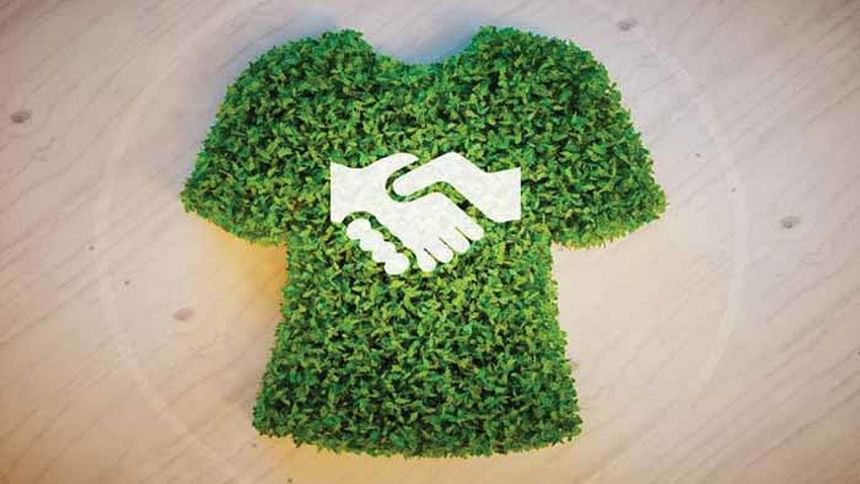Key sustainability issues for 2021

Issues around sustainability come and go, but some topics will remain as important now as they were before the current global pandemic began.
Three issues I am confident will remain prominent in 2021—and in years to come—are carbon emissions, circular economy, and renewable energy. I follow the global fashion industry very closely and these are subjects which brands of all sizes and types are coming back to time and again.
The first and third of these issues are linked—as I will point out below—while the second, circular economy, is quite specific. Some thought circularity might be a passing fad in our industry, but evidence suggests it is not going away.
Let's focus on carbon emissions to begin with. This is an interesting one as 2020 actually saw some of the most significant falls in carbon emissions since the Second World War. In the US, the most recent figures show that carbon emissions fell by more than 10 percent, and this enabled the country to meet long-standing carbon targets. The reason emissions fell is, of course, due to the global pandemic. The last major economic recession of 2008/09, for instance, saw global carbon emissions fall dramatically.
Regardless of this, the trajectory for carbon emissions is still decidedly upwards. Moreover, the fixation on emissions remains the same for fashion brands and retailers—the most significant customer base of Bangladesh. As far as brands and retailers are concerned, sourcing hubs such as ours are critical in enabling them to reduce carbon emissions, as most of these emissions occur in supply chains.
The RMG industry of Bangladesh is connected to the global supply chain and our exports are mostly destined for the EU, US and Canada. The EU aims to become carbon neutral by 2050 and building an economy of net-zero GHGs emission. The new democrat led US government is also supposed to be onboarded the Paris Agreement and Canada led by Trudeau is also opting for carbon neutrality by 2050. The apparel industry and our overall exports are heavily dependent on these countries and we mostly cater to brands from these regions. Therefore, to keep our foothold in the global business landscape, we have to align our strategies to be in the business.
On this front, change is afoot right now. Brands and retailers are hopeful that countries such as ours will move away from dirty, high emission fuels—essentially coal. It's welcoming that Bangladesh recently announced it was set to review the number of coal-based power plants it is looking to build moving forwards as it looks to reduce its dependence on coal.
About 3 percent of Bangladesh's power currently comes from coal but the government has plans to build 29 new coal-fired power plants in the next two decades which would increase that figure to 35 percent.
However, reports suggest that our government officials are now thinking again. One of the reasons for that is that the price of coal has increased since the plan was first announced. Yet, perhaps the bigger reason is that building more coal plants is incompatible with achieving the goals of the Paris Agreement to limit planetary heating and carbon emissions.
A shift away from coal is in our own interests for several reasons. Bangladesh is often included on the list of countries which are at most risk from the impacts of rising global temperatures, from more extreme storms to floods and rising sea levels. And rising temperatures are caused by carbon emissions—of significant contributor to which is coal power.
There is another reason why shifting away from carbon-intensive coal is in the interests of Bangladesh. Last year, global apparel brands including Adidas, Puma, Gap and H&M wrote to the Cambodian Government bemoaning the country's move towards fossil-fuelled power projects.
As indicated, many leading brands have set emission reduction targets in their supply chains in line with their Science-Based Targets goals. However, Cambodia has also in recent years approved a raft of coal-fired power plant projects in line with government plans for the development of additional power sources between 2020 and 2030. Local sources claimCambodia plans to nearly triple the amount of power it generates from coal in the coming years, to the dismay of brands sourcing from the country.
Meanwhile, staying on this issue, another of our competitors, China, has announced in recent months that it intends its coal industry to play an increasingly important role in the production of synthetic fibres such as polyester. Last year, one of China's leading chemical company announced it had developed a way to convert coal into polyester yarn, to be used in the production of clothing, among other products.
These are surprising developments given what I have written above about brands looking at how they can reduce their carbon emissions in supply chains. They also offer an understanding of the challenges countries like ours face in terms of balancing the needs of our own power infrastructure with the requirement to also keep our customers happy regarding carbon emissions, renewable energy and so on.
As indicated, carbon emissions and renewable energy are two sides of the same coin. Renewable energy will remain high on the agenda for apparel brands and retailers. By this I mean the talk will be of them moving towards renewable energy in all their owned operations (stores and retail outlets). And also working with their suppliers to look at renewable energy options, of which there are a great many.
The message in all this is clear for Bangladesh: if we want to be a major player globally, if we want to remain relevant, we have to be thinking of a low carbon, renewable energy future. And I am not talking about in 10- or 20-years' time, I am talking about here and now. Our customers will not wait for us on this, and why should they?
Finally, to the third big issue of 2021: circular economy. A McKinsey & Co. report suggests that adoption of circular economy in the fashion industry would reduce carbon emission by 10 percent so there is a causal link of circular economy and climate change too. Circularity is not just recycling, it is about closing the linear economic loop to be sustainable. In its purest form circularity means taking old clothing, putting it through a chemical process to break down the fibres into their original building block monomers and then creating new fibres from these to be used for new clothing.
The above is the ideal. Yet the technology, infrastructure, and supply chains for the above are nowhere near maturity yet. The market is not ready, although it soon will be. To have a broader adaptability of circular economy we also need comprehensive policies.
In the meantime, we can focus on good old fashioned reduce, re-use and repair, all of which are important in reducing carbon emissions and our impact on the planet. We can all play an important role as individuals as far as this is concerned.
Our businesses must also be ready to step up to the plate here. Brands and retailers are looking to supply chains for solutions in recycling. A bright future awaits supply chains which can provide these solutions, enabling brands to meet their circularity goals and objectives.
Mostafiz Uddin is the Managing Director of Denim Expert Limited. He is also the Founder and CEO of Bangladesh Apparel Exchange (BAE).
Email: [email protected].

 For all latest news, follow The Daily Star's Google News channel.
For all latest news, follow The Daily Star's Google News channel. 



Comments